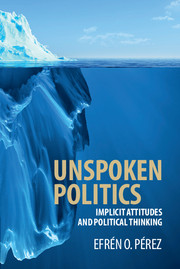Book contents
- Frontmatter
- Contents
- List of Tables and Figures
- Acknowledgments
- 1 Implicit Thoughts, Explicit Decisions
- 2 Two Ways of Thinking, Two Types of Attitudes
- 3 Implicit Expectations and Explicit Political Reasoning
- 4 Ghost in the Associative Machine
- 5 Unstated: The Measurement of Implicit Attitudes
- 6 Incognito: The Subconscious Nature of Implicit Expectations
- 7 In Deliberation's Shadow: Education, (Un)awareness, and Implicit Attitudes
- 8 In Black and White: Race, Group Position, and Implicit Attitudes in Politics
- 9 Conclusion: Implicit Attitudes and Explicit Politics
- Note on the Studies
- References
- Index
- Books in the series
6 - Incognito: The Subconscious Nature of Implicit Expectations
Published online by Cambridge University Press: 05 March 2016
- Frontmatter
- Contents
- List of Tables and Figures
- Acknowledgments
- 1 Implicit Thoughts, Explicit Decisions
- 2 Two Ways of Thinking, Two Types of Attitudes
- 3 Implicit Expectations and Explicit Political Reasoning
- 4 Ghost in the Associative Machine
- 5 Unstated: The Measurement of Implicit Attitudes
- 6 Incognito: The Subconscious Nature of Implicit Expectations
- 7 In Deliberation's Shadow: Education, (Un)awareness, and Implicit Attitudes
- 8 In Black and White: Race, Group Position, and Implicit Attitudes in Politics
- 9 Conclusion: Implicit Attitudes and Explicit Politics
- Note on the Studies
- References
- Index
- Books in the series
Summary
Imagine the following scenario. A person sits behind a computer to view two brief movie reels, each one lasting only 16 seconds and presented on a purely random basis. Frame by frame, this individual sees nothing more on the screen than another person's face as it evolves from happiness, to an ambiguous expression, and then to anger. The individual watching these reels is simply instructed to press the space bar the moment he or she senses a shift in the facial expression of the person on the screen, from pleasant-looking to outright menacing. How long do you think it will take someone to detect anger in the face of another?
The answer is that it will depend on that person's level of implicit attitude. More precisely, it will depend on their implicit attitude toward African Americans. For the one difference between the two reels just described is the race of the person that is showcased in each one. In one film, the person is conspicuously African American; in the other, the person is identifiably white.
In fact, when two social psychologists conducted a set of experiments along these lines (Hugenberg and Bodenhausen 2003), they discovered that individual differences in implicit attitude toward blacks (as measured by the Implicit Association Test [IAT]) explained the alacrity with which participants sensed anger in the African American person's face, but not the white person's expression. Specifically, individuals with more negative implicit attitudes toward blacks were about 2.5 seconds faster at detecting a menacing facial expression, even if the face was objectively ambiguous – neither happy nor angry in clearly visible terms. In a manner reminiscent of Mark Lyttle's mistaken deportation to Mexico (Chapter 1), implicit attitude led some individuals to see something that was not really there, without their knowing that it had.
This is, of course, only one report from one research team. Yet dispatches from other studies conducted by other social psychologists suggest similar patterns (e.g., Fazio and Dunton 1997; Gawronski et al. 2003). The cumulative lesson from these laboratory investigations seems to be this: implicit attitude can color how individuals interpret the world around them, and it can do so without people being fully aware of this influence.
- Type
- Chapter
- Information
- Unspoken PoliticsImplicit Attitudes and Political Thinking, pp. 111 - 128Publisher: Cambridge University PressPrint publication year: 2016



